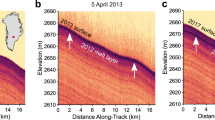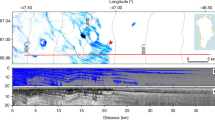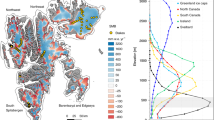Abstract
Surface melt and subsequent firn air depletion can ultimately lead to disintegration of Antarctic ice shelves1,2 causing grounded glaciers to accelerate3 and sea level to rise. In the Antarctic Peninsula, foehn winds enhance melting near the grounding line4, which in the recent past has led to the disintegration of the most northerly ice shelves5,6. Here, we provide observational and model evidence that this process also occurs over an East Antarctic ice shelf, where meltwater-induced firn air depletion is found in the grounding zone. Unlike the Antarctic Peninsula, where foehn events originate from episodic interaction of the circumpolar westerlies with the topography, in coastal East Antarctica high temperatures are caused by persistent katabatic winds originating from the ice sheet’s interior. Katabatic winds warm and mix the air as it flows downward and cause widespread snow erosion, explaining >3 K higher near-surface temperatures in summer and surface melt doubling in the grounding zone compared with its surroundings. Additionally, these winds expose blue ice and firn with lower surface albedo, further enhancing melt. The in situ observation of supraglacial flow and englacial storage of meltwater suggests that ice-shelf grounding zones in East Antarctica, like their Antarctic Peninsula counterparts, are vulnerable to hydrofracturing7.
This is a preview of subscription content, access via your institution
Access options
Subscribe to this journal
Receive 12 print issues and online access
$209.00 per year
only $17.42 per issue
Buy this article
- Purchase on Springer Link
- Instant access to full article PDF
Prices may be subject to local taxes which are calculated during checkout




Similar content being viewed by others
References
Van den Broeke, M. R. Strong surface melting preceded collapse of Antarctic Peninsula ice shelf. Geophys. Res. Lett. 32, 1–4 (2005).
Kuipers Munneke, P., Ligtenberg, S. R. M., Van Den Broeke, M. R. & Vaughan, D. G. Firn air depletion as a precursor of Antarctic ice-shelf collapse. J. Glaciol. 60, 205–214 (2014).
Rignot, E. et al. Accelerated ice discharge from the Antarctic Peninsula following the collapse of Larsen B ice shelf. Geophys. Res. Lett. 31, L18401 (2004).
Hubbard, B. et al. Massive subsurface ice formed by refreezing of ice-shelf melt ponds. Nat. Commun. 7, 11897 (2016).
Cape, M. R. et al. Foehn winds link climate-driven warming to ice shelf evolution in Antarctica. J. Geophys. Res. 120, 11037–11057 (2015).
Luckman, A. et al. Surface melt and ponding on Larsen C Ice Shelf and the impact of Föhn winds. Antarct. Sci. 26, 625–635 (2014).
Pollard, D. & Deconto, R. M. Contribution of Antarctica to past and future sea-level rise. Nature 531, 591–597 (2016).
Bindschadler, R. et al. Getting around Antarctica: new high-resolution mappings of the grounded and freely-floating boundaries of the Antarctic ice sheet created for the International Polar Year. Cryosphere 5, 569–588 (2011).
Fürst, J. J. et al. The safety band of Antarctic ice shelves. Nat. Clim. Change 6, 2014–2017 (2016).
Depoorter, M. A. et al. Calving fluxes and basal melt rates of Antarctic ice shelves. Nature 502, 89–92 (2013).
Banwell, A. F., MacAyeal, D. R. & Sergienko, O. V. Breakup of the Larsen B ice shelf triggered by chain reaction drainage of supraglacial lakes. Geophys. Res. Lett. 40, 5872–5876 (2013).
Ligtenberg, S. R. M., Kuipers Munneke, P. & Van den Broeke, M. R. Present and future variations in Antarctic firn air content. Cryosphere 8, 1711–1723 (2014).
Macayeal, D. R. & Sergienko, O. V. The flexural dynamics of melting ice shelves. Ann. Glaciol. 54, 1–10 (2013).
Liston, G. E., Winther, J. G., Bruland, O., Elvehøy, H. & Sand, K. Below-surface ice melt on the coastal Antarctic ice sheet. J. Glaciol. 45, 273–285 (1999).
Phillips, H. A. Surface meltstreams on the Amery Ice Shelf, East Antarctica. Ann. Glaciol. 27, 177–181 (1998).
Kingslake, J., Ng, F. & Sole, A. Modelling channelized surface drainage of supraglacial lakes. J. Glaciol. 61, 185–199 (2015).
Langley, E. S., Leeson, A. A., Stokes, C. R. & Jamieson, S. S. R. Seasonal evolution of supraglacial lakes on an East Antarctic outlet glacier. Geophys. Res. Lett. 43, 8563–8571 (2016).
Lenaerts, J. T. M. et al. High variability of climate and surface mass balance induced by Antarctic ice rises. J. Glaciol. 60, 1101–1110 (2014).
Trusel, L. D., Frey, K. E., Das, S. B., Kuipers Munneke, P. & Van den Broeke, M. R. Satellite-based estimates of Antarctic surface meltwater fluxes. Geophys. Res. Lett. 40, 6148–6153 (2013).
Lenaerts, J. T. M. & Van den Broeke, M. R. Modeling drifting snow in Antarctica with a regional climate model: 2. Results. J. Geophys. Res. 117, D05108 (2012).
Das, I. et al. Influence of persistent wind scour on the surface mass balance of Antarctica. Nat. Geosci. 6, 367–371 (2013).
Scambos, T. A., Haran, T. M., Fahnestock, M. A., Painter, T. H. & Bohlander, J. MODIS-based Mosaic of Antarctica (MOA) data sets: continent-wide surface morphology and snow grain size. Remote Sens. Environ. 111, 242–257 (2007).
Callens, D. et al. Mass balance of the Sør Rondane glacial system, East Antarctica. Ann. Glaciol. 56, 63–69 (2015).
Le Brocq, A. M. et al. Evidence from ice shelves for channelized meltwater flow beneath the Antarctic Ice Sheet. Nat. Geosci. 6, 945–948 (2013).
Banwell, A. F. & Macayeal, D. R. Ice-shelf fracture due to viscoelastic flexure stress induced by fill/drain cycles of supraglacial lakes. Antarct. Sci. 27, 587–597 (2015).
Scambos, T. A. et al. Extent of low-accumulation ‘wind glaze’ areas on the East Antarctic plateau: implications for continental ice mass balance. J. Glaciol. 58, 633–647 (2012).
Lenaerts, J. T. M., Vizcaino, M., Fyke, J., Kampenhout, L. & van den Broeke, M. R. Present-day and future Antarctic ice sheet climate and surface mass balance in the Community Earth System Model. Clim. Dynam. 47, 1367–1381 (2016).
Van den Broeke, M. R., van de Wal, R. S. W. & Wild, M. Representation of Antarctic katabatic winds in a high-resolution GCM and a note on their climate sensitivity. J. Clim. 10, 3111–3130 (1997).
Hui, F. et al. Mapping blue-ice areas in Antarctica using ETM + and MODIS data. Ann. Glaciol. 55, 129–137 (2014).
Ligtenberg, S. R. M., Helsen, M. M. & Van den Broeke, M. R. An improved semi-empirical model for the densification of Antarctic firn. Cryosphere 5, 809–819 (2011).
Kuipers Munneke, P., Van den Broeke, M. R., King, J. C., Gray, T. & Reijmer, C. H. Near-surface climate and surface energy budget of Larsen C ice shelf, Antarctic Peninsula. Cryosphere 6, 353–363 (2012).
Van Angelen, J. H. et al. Sensitivity of Greenland Ice Sheet surface mass balance to surface albedo parameterization: a study with a regional climate model. Cryosphere 6, 1175–1186 (2012).
Drews, R. Evolution of ice-shelf channels in Antarctic ice shelves. Cryosphere 9, 1169–1181 (2015).
Koenig, L. S. et al. Wintertime storage of water in buried supraglacial lakes across the Greenland Ice Sheet. Cryosphere 9, 1333–1342 (2015).
Acknowledgements
Field data were collected in the framework of the BENEMELT project, in collaboration with the BELSPO project ICECON. BENEMELT benefits from the InBev-Baillet Latour Antarctica Fellowship, a joint initiative of the InBev-Baillet Latour Fund and the International Polar Foundation (IPF) that aims to promote scientific excellence. We gratefully acknowledge field support from IPF, BELSPO, AntarctiQ, the Belgian Polar Secretariat and the Belgian military. We thank G. Eagles, T. Binder and C. Müller from the Alfred Wegener Institute, who first discovered the circular melt feature in 2015. This study is partly funded by Utrecht University through its strategic theme Sustainability, sub-theme Water, Climate & Ecosystems. This work was carried out under the programme of the Netherlands Earth System Science Centre (NESSC), financially supported by the Ministry of Education, Culture and Science (OCW). J.T.M.L. is supported by NWO ALW through a Veni postdoctoral grant. S.L. was supported as a post-doc by FWO. R.D. was funded by the FNRS Project MEDRISSM and partial support by the Deutsche Forschungsgmeinschaft with a grant SPP ‘Antarctic Research’ MA 3347/10-1. Analysis and graphics are made using QGIS package Quantarctica, and the NCAR Command Language (http://dx.doi.org/10.5065/D6WD3XH5). TanDEM-X SLC data were provided by the German Space Agency (DLR) within the proposal ATI_GLAC0267.
Author information
Authors and Affiliations
Contributions
J.T.M.L. and S.L. contributed equally to this work. J.T.M.L. conceived the study, led the first field season with support from F.P., performed climate simulations with support from W.J.v.d.B., E.v.M. and M.R.v.d.B. and wrote an initial version of the paper. S.L. led the second field season, with support from R.D. and M.E. and was responsible for the remote sensing analyses. R.D. analysed the GPR data. S.R.M.L. was responsible for the firn model simulations. S.B. compiled the ALOS data and the RBIS thickness and basal melting data sets. C.J.P.P.S. performed quality control of the weather station observations. V.H. and O.E. provided a first analysis of the circular melt feature and provided the high-resolution TanDEM-X DEM. All authors contributed to the writing of the manuscript.
Corresponding author
Ethics declarations
Competing interests
The authors declare no competing financial interests.
Supplementary information
Supplementary Information
Supplementary Information (PDF 4249 kb)
Supplementary Information
Supplementary movie 1 (MOV 2952 kb)
Supplementary Information
Supplementary movie 2 (MOV 6429 kb)
Rights and permissions
About this article
Cite this article
Lenaerts, J., Lhermitte, S., Drews, R. et al. Meltwater produced by wind–albedo interaction stored in an East Antarctic ice shelf. Nature Clim Change 7, 58–62 (2017). https://doi.org/10.1038/nclimate3180
Received:
Accepted:
Published:
Issue Date:
DOI: https://doi.org/10.1038/nclimate3180



